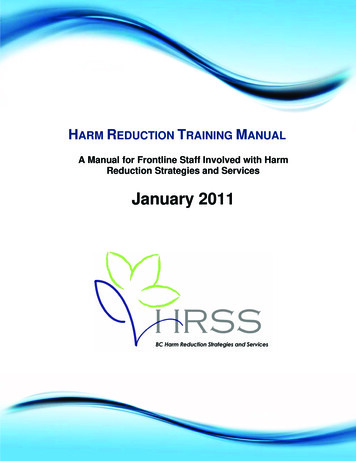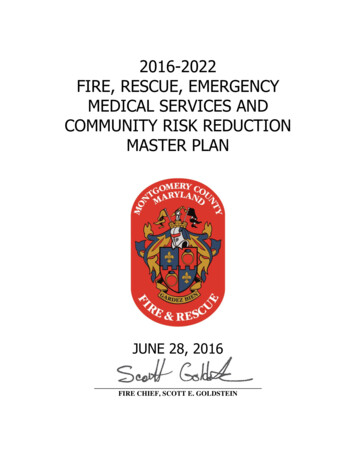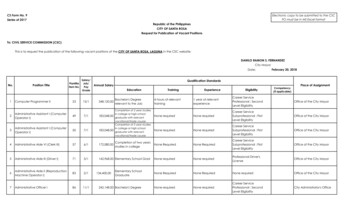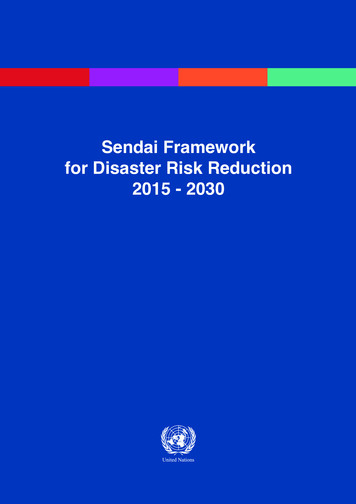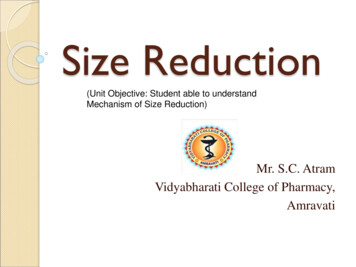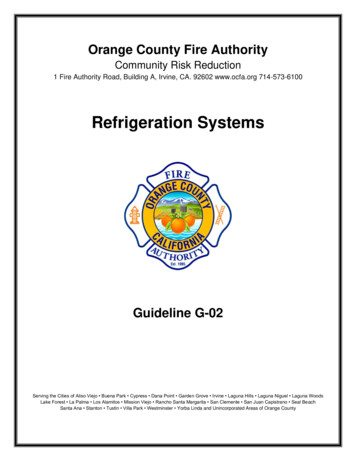
Transcription
Orange County Fire AuthorityCommunity Risk Reduction1 Fire Authority Road, Building A, Irvine, CA. 92602 www.ocfa.org 714-573-6100Refrigeration SystemsGuideline G-02Serving the Cities of Aliso Viejo Buena Park Cypress Dana Point Garden Grove Irvine Laguna Hills Laguna Niguel Laguna WoodsLake Forest La Palma Los Alamitos Mission Viejo Rancho Santa Margarita San Clemente San Juan Capistrano Seal BeachSanta Ana Stanton Tustin Villa Park Westminster Yorba Linda and Unincorporated Areas of Orange County
Refrigeration Systems: G-02July 1, 2020Refrigeration SystemsPURPOSEThe intent of this guideline is to clarify certain requirements for refrigeration systems regulatedby Chapter 6 of the 2019 California Fire Code (CFC) and by Chapter 11 of the 2019 CaliforniaMechanical Code (CMC). Not all refrigeration system requirements will be identified in thisguideline.Refrigeration systems pose a significant risk to workers and the public if refrigerant is releasedor leaked out in sufficient quantities. Freon-based refrigerants are the most widely used inOrange County; they are colorless and odorless gases undetectable by our senses. Accidentsaround the country involving ammonia refrigeration continue to injure and kill people. However,any refrigerant leak will displace oxygen in a closed area, and can lead to asphyxiation.SCOPEThis guideline is applicable to existing refrigeration systems and new refrigeration systemswhere the amount of refrigerant in a single system exceeds 220 pounds of Group A1 or 30pounds of any other Group. Existing systems will be regulated by the Code in effect at the timeof construction or major upgrade, while new installations are regulated by the 2019 CFCChapter 6 and 2019 CMC Chapter 11. When an existing refrigeration system is upgraded ormodified, the Fire Code Official will determine how the application of the codes shall be applied.The following definitions are provided to assist in the use of this guideline:IDLH (Immediately Dangerous to Life and Health): A concentration of airborne contaminants,normally expressed in parts per million (ppm) , that represents the maximum level from whichone is capable of escaping within 30 minutes without escape-impairing symptoms orirreversible health effects.LFL (Lower Flammability Limit): The minimum concentration of a substance that propagates aflame through a homogeneous mixture of the substance in air under specified test conditions.LFL is sometimes referred to as LEL (Lower Explosive Limit).PEL (Permissible Exposure Limit): The time-weighted average concentration (set by OSHA)for a normal 8-hour workday and a 40-hour workweek to which nearly all workers can berepeatedly exposed without adverse effects.1
Refrigeration Systems: G-02July 1, 2020ClassificationRefrigerants are classified into groups according to toxicity and flammability. A1, A2,A2L, A3 are flammable. B1, B2, B2L, B3 are toxic. Example: ammonia is a Class B2Lwhile R-404A and R-507A are Class A1. The “L” designation is for slightly flammable.Toxicity Classification and Flammability Classifications are defined in the 2019 CMC.PLAN SUBMITTAL REQUIREMENTSSubmit two sets of scaled plans and an electronic copy of the plans in PDF format. Theplans/shop drawings shall contain the following information, when any of the sections involvethis project.1. Permits and Plans: A permit is required to install or operate a mechanical refrigerationsystem if the amount in any single system is greater than 220 pounds of Group A1refrigerants or 30 pounds of any other Group Installation, upgrade, retrofit, andmodification plans of refrigeration systems shall be submitted for review to the OCFA priorto installation. The plans shall include the scope of work, design details, specifications ofthe system, and demonstrate full compliance with applicable codes and industrystandards/guidelines (such as IIAR, ASHRAE, CFC, or Uniform Mechanical code [whichis the base code for the CMC]). Any combination of these codes and/or standards aresubject to approval by OCFA.A. Access: Refrigeration systems shall be accessible to the fire department at all timesas required by the Fire Code Official. OCFA recommends an approved Knox keybox for machine rooms, compressor rooms or mechanical rooms (per CFC).B. Emergency Fire Control Box: Emergency fire control boxes are no longer requiredby the CFC or the CMC. Existing refrigeration systems are expected to maintain andtest their fire control box. Removing or altering the fire control box shall be approvedby OCFA. The fire control box for existing ammonia refrigeration systems shall be inaccordance with the Code in effect at the time of construction or major upgrade, andcontain a compressor shut down switch, clear emergency instructions, and therefrigeration engineer’s emergency 24 hour telephone contact numbers.C. Ammonia Refrigerant: Systems containing ammonia refrigerant that have anemergency vapor discharge to the atmosphere, must be through an approvedtreatment, flaring, or diffusion systems (2019 CFC 605.12.4). If another method ofsafe emergency discharge is currently in use such as a sanitary drain system, thebusiness owner shall be required to show this drain is acceptable by the localsanitation authority.D. The following is a summary of significant machinery room safety features (per CFCChapter 6):1) Vapor leak detectors to have blue visual strobes in/out of exits2) Vapor leak detectors to have local audible horns in/out of exits3) Normal ventilation4) Emergency purge ventilation2
Refrigeration Systems: G-02July 1, 20205) Automatic shutdown device6) Emergency shutdown device7) Exit door 36” width, swing outward, panic hardware, illuminated signE. Testing of Equipment: At the time of the final NCO inspection, the owner/operatorshall demonstrate that the leak detection, notification, automatic shutdown, and CallOut features are functioning as per the plan design. It is the responsibility of thecontractor to coordinate all trades for the inspections.2. Leak Detection and Alarms: This section’s purpose is to provide additional direction inmeeting the refrigerant alarm and detection requirements of the 2019 CFC and the 2019CMC.A. Enclosed Machinery Rooms require refrigerant alarm and detection systems.B. Walk-in freezers and coolers require refrigerant alarm and detection systems ifrefrigerant quantities exceed 2019 CMC Table 1102.3 amounts as indicated on theOCFA Refrigerant Disclosure Form.C. Refrigerant alarm and detection systems shall provide supervisory trouble andsupervisory detection signals to an off-premises central monitoring station. Therefrigerant alarm and detection systems should be connected to a security panel orlocal fire alarm/sprinkler monitoring system, or auto dialer directly to arefrigeration engineer with a maintenance contract.D. Refrigerant alarm and detection signals shall not activate fire alarm/sprinklermonitoring alarm devices. Only the blue-colored horn/strobes of the refrigerant alarmand detection system shall be activated by a refrigerant detector.E. OCFA may require refrigeration trouble and/or detection signals as alarm signals(and dispatch first responders) if unusually hazardous conditions may result from asignificant refrigerant leak.3
Refrigeration Systems: G-02July 1, 2020REFRIGERANT DISCLOSURE FORMDate:OCFA SR# (if applicable):Business Name (Where system is located):Complete Business Address:Business Phone: ()Refrigerant Contractor or Engineering Firm:Refrigerant Contractor or Engineering Firm Phone: ()Instructions:Column [1]Column [2]Column [3]Column [4]Column [5]Column [6]Column [7][1] IdentifyEachSystemIdentify each refrigerant system included in this submittal.List the refrigerant name and the CMC Table 1102.3 Refrigerant Concentration Limit(RCL).Identify the refrigerant IDLH or PEL or LEL from Table 1102.3Identify the total amount of refrigerant in each system (in pounds).Identify the volume of the refrigerated space (in cubic feet).Calculate by using: column [4] divided by column [5] divided by 1000. If this valueexceeds the RCL Factor for the specific refrigerant type, then submit a refrigeration planincluding an alarm and detection planWhen Column [6] exceeds the Factor in CMC Table 1102.3 for each refrigerated space,then section CMC 1104.2 applies, enter Yes or No?[2] Refrigerant Nameand RCL Factor[3] IDLH orPEL or LEL[4] Quantity ofRefrigerant(Pounds)Completed by (Print name and sign)[5] Volume ofRefrigeratedspace(Cubic Feet)[6] PoundsofRefrigerantper 1,000Cubic FeetofRefrigeratedSpace[7] DoesColumn [6]QuantityExceed theFactor?(Y/N)Date CompletedNote: If more than one system is connected to a common header or cooling tower/condenser,then the total refrigerant charge is used in Column [4]4
refrigerant alarm and detection systems should be connected to a security panel or local fire alarm/sprinkler monitoring system, or auto dialer directly to a refrigeration engineer with a maintenance contract. D. Refrigerant alarm and detection signals shall not activate fire alarm/sprinkler monitoring alarm devices.


